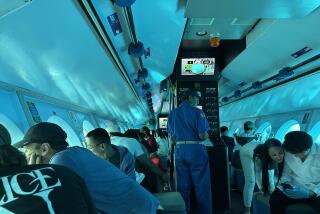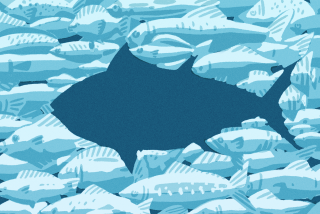Nothing Tops This Tuna Fishing
- Share via
SAN DIEGO — It was an impressive sight: monstrous tuna standing on their heads, lined up along the stern rail of the Excel in a display intended to show all comers what a long-range fishing trip is all about.
And come they did, not only dozens of fishermen but passersby, friends and peddlers.
It’s a spectacle that occurs every time a boat returns from the Revillagigedo Islands, a remote, four-island chain beginning about 240 miles south of Cabo San Lucas and stretching to the southwest 260 miles farther.
No other place in the world boasts such a sizable population of giant yellowfin tuna.
And no other port, with the occasional exception of Cabo San Lucas, offers anglers a chance to go there and catch more tuna than they know what to do with. A chance to do battle with a fish so massive and powerful that hooking one has about the same effect as hooking the bumper of a speeding car.
“Total chaos,” said Ken Cirks, 32, a regular long-ranger from Orange. “I mean, total chaos.”
And as the 123-foot Excel pulled into its slip on a recent sunny Sunday morning, it quickly became apparent that while it does not rival the on-site action at the islands, the end of a long-range fishing trip is quite an event as well.
Passengers who are dropped off at Cabo San Lucas and fly home a few days early, as most long-rangers do, arrive early to greet the boat. They bring their wives, friends, brothers and sisters.
Waiting for the boat, they relive the misery and the glory that come from battles against titanic tuna that lasted well into the starry night.
“My legs hurt so bad after the first three days, I could hardly walk,” said Jerry Thergesen, 32.
“I worked out a lot before the trip and it still killed me. I felt it on parts of my body where I hadn’t expected it.”
Understandable. Some of the tuna, particularly those hooked in the darkness, crash into the boat in a panic after taking the bait and are hauled overboard within minutes. But others streak downward and can take several hours to land.
Skipper Randy Toussaint’s 28 passengers, on his first trip of the season to the islands, spent eight days and nights at Clarion Island--the southernmost of the chain--and landed more than 20 tuna weighing at least 200 pounds.
These were the fish that caught everyone’s attention when the boat was backed into its slip. They were the fish surrounded by 100- and 150-pounders that littered Toussaint’s deck. And by a few hundred missile-shaped wahoo, caught for good measure.
“We caught five tons the first day,” said Dennis Braid, 49, a tackle manufacturer from Palmdale who frequently charters the Excel out of Fisherman’s Landing.
Listening to all this, one can’t help but wonder what it is that possesses a person to spend nearly $3,000 to board a boat, spend four days traveling on what is sometimes a very rough sea, then spend eight days and nights fishing until it hurts before the long trip back.
Surely, such a trip is strictly for the hard-core angler.
“I’ll tell you how hard-core it is,” said Braid, who has made the trip more than 20 times. “This guy here is a bit of a clown, so we took his boots, filled them with water, put scads [small baitfish] in them, and put them in the freezer overnight. We get up to that kind of stuff.”
Seriously, though, Braid said, it’s the beauty and remoteness of the islands, and the camaraderie--and of course the challenge associated with catching eight-foot-long tuna that keeps him coming.
“On a 16-day trip you have an opportunity to fish 24 hours a day, so you have to learn, within the first two days, to start pacing yourself--when are you going to sleep, and when do you want to fish?” he said. “And sometime in between you have to do a little bit of rigging, and you have to eat a little bit too. So you’ll find that very seldom will you have everybody at the rail at the same time.
“There are certain times of the day, where there will only be three or four people with lines in the water. Two years ago, on the second call for lunch, there were only three guys fishing. I walked out and threw a bait in the water and hooked a 328-pounder.”
The all-tackle world record is a 388-pound yellowfin caught at San Benedicto--the northernmost island--in 1977.
That is what keeps Ralph Mikkelsen coming. Mikkelsen, 65, of Northridge, is hoping not only to break that record, but to become the first person to catch a 400-pound yellowfin.
And fortunately for him, he has a wealthy wife who indulges him to the point that he can make several trips a year. He has made 40 overall, and his biggest tuna to date is a 333-pounder.
He caught one in the 200-pound range on this particular trip, but, he says, “My next trip is in February, and then I’ll go again in May.”
Mikkelsen said he actually releases some of his catches, and Toussaint said it is a common practice to release the smaller tuna.
But watching the crew tote cart after cart of tuna up the ramp, dumping them on the concrete near the landing’s waterfront scale, one would find that difficult to believe.
As the piles mounted, and as the fishermen tried to keep track of which tuna were theirs, an even bigger crowd gathered to get a closer look at these blimp-shaped objects being dragged about.
One passerby seemed disturbed by it all, asking a friend in a cynical tone: “Think they caught enough?”
Good question. Experts insist that the yellowfin tuna resource is as healthy as ever. But still, what in the name of Neptune does one do with 1,000 pounds or more of tuna?
Turns out there are a number of options. Anglers can trade their whole tuna to the man in the truck for fillets. They can arrange with the landing to have it canned, smoked or both. Or they can donate it to charity and write part of their trip off.
“You get a $2-per-pound value and get a certificate for a tax deduction,” Braid said. “I’m fine on cans now, so I’ll trade all my fish straight for charity. You just tell them what you want there [at the landing] and they’ll calculate it out, and give you a written receipt that’s legitimate for the IRS. I caught 1,200-1,400 pounds, but I have wahoo there as well and they don’t count wahoo, so I’ll give that to my employees.”
Cirks said he was just going to take his tuna home and have at it with the fillet knife.
“I figure it will take until midnight to fillet it all,” he said. “The last time it took three days. But this time we have people coming over to help.”
Said his girlfriend, Kathy Howard: “Anybody wants any fish, you come and clean it yourself. Because we always give away lots; but nobody wants to help clean it. We said this time: ‘Anybody wants any this year, you have to help us.’ So we probably have about 20 people coming over.”
TOTALLY AWESOME PRONGHORN, DUDE
“Hunting in Wyoming is as sacred as surf boarding in California.”
So says Don Baumberger, a former Wyoming school superintendent, in reference to the annual “hunting holiday” during which students are given a day or two off each fall to spend time with their families in the field.
Twenty-seven of Wyoming’s 49 public school districts observed the holiday in 1995, most on the Monday after the traditional opening day of hunting season in mid-October. Seven more took two days off, making it a four-day weekend.
Surfers in the Golden State might appreciate such a holiday for them. Then again, a principal in any beach city would probably say that students don’t need an official holiday to take a surfing safari.
SIGN OF THE TIMES . . .
Shot Business magazine reports that 2,556,000 women hunt with firearms, up 23% from 1988, and that females now make up 13% of the overall hunting population. The Archery Manufacturers and Merchants Organization, meanwhile, reports a similar increase in female participation: Of the 9,240,000 archery hunters in the United States, 1,636,000, or about 18%, are women.
LOOKING BACK . . .
. . . to Avalon in 1890. An abalone fisherman on Catalina was apparently fed up with having to dive into the water to search for the large mollusks, so he installed glass in the bottom of his row boat “and thus started the craze that still fascinates visitors to the island,” according to California Fishing Ports, a history compiled by the Department of Fish and Game in 1954.
More to Read
Sign up for The Wild
We’ll help you find the best places to hike, bike and run, as well as the perfect silent spots for meditation and yoga.
You may occasionally receive promotional content from the Los Angeles Times.






